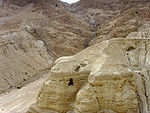Ein Feshkha
1838 archaeological discoveries1969 establishments in the Israeli Military GovernorateAll accuracy disputesArchaeological sites in the West BankDead Sea Scrolls ... and 9 more
Former populated places in Southwest AsiaHerod AgrippaImportant Bird Areas of the State of PalestineIron Age sites in AsiaJews and Judaism in the Roman Republic and the Roman EmpireNature reserves in Israeli-occupied territoriesNature reserves in PalestineProtected areas established in 1969Qumran

Ein Feshkha (Arabic: عين فشخة, also Ain Al-Fashka) or Einot Tzukim (Hebrew: עינות צוקים, lit. 'cliff springs') is a 2,500 ha nature reserve and archaeological site on the north-western shore of the Dead Sea, about 3 km (1.9 mi) south of Qumran in the West Bank. It is located just north of the headland Râs Feshkhah, the "headland of Feshkhah". Within the reserve is a group of springs of brackish water. The nature reserve consists of an open section with pools of mineral water for bathing surrounded by high foliage and a section that is closed to visitors to protect the native flora and fauna.
Excerpt from the Wikipedia article Ein Feshkha (License: CC BY-SA 3.0, Authors, Images).Ein Feshkha
Dead Sea, Megilot Yam HaMelakh Regional Council
Geographical coordinates (GPS) Address Nearby Places Show on map
Geographical coordinates (GPS)
| Latitude | Longitude |
|---|---|
| N 31.7144 ° | E 35.4533 ° |
Address
Dead Sea
Megilot Yam HaMelakh Regional Council
Judea and Samaria, Palestinian Territories
Open on Google Maps









